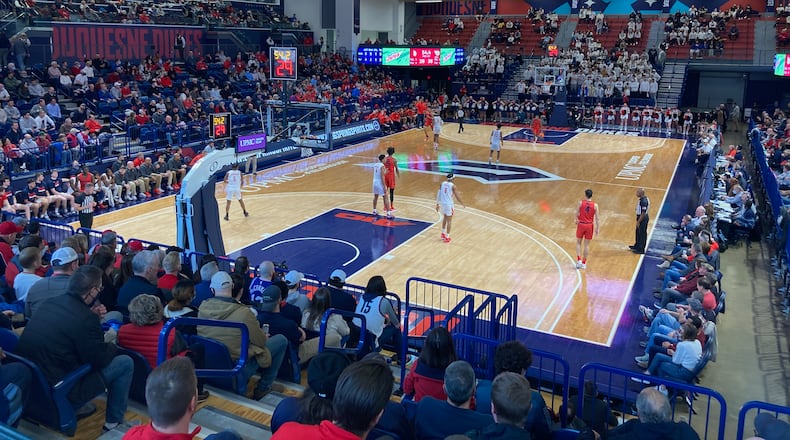WHIO’s Larry Hansgen ranked the A-10 arenas in 2016 and Duquesne’s arena 12th. I’d have to think he’d have it higher now. I’ve been to every arena in the conference at least three times. Here’s my attempt to rank the arenas from best to worst.
1. UD Arena: This was an easy and obvious choice even before the three-year, $76.2 million upgrade finished in 2019. Dayton’s home has the most seats (13,407), the best history — more NCAA tournament games than any arena in the nation — and the best amenities. It’s also the only A-10 arena that carries the name of its university.
2. Siegel Center: Like Dayton’s home, Virginia Commonwealth’s arena, which opened in 1999, scores a lot of points by being full. Until the pandemic ended its sellout streak, it had sold out every home game (166 in a row) since 2011. Capacity wise, the Siegel Center sits near the middle of Division I. It ranks 151st (7,631). I give the arena bonus points points for having framed newspapers from VCU’s greatest victories on the walls.
3. Chaifetz Arena: The home of the Saint Louis Billikens seats 10,600 fans, making it the second-largest arena in the conference. It opened in 2008 and is one of the best-looking arenas in the conference from the outside and not a bad to place to watch a basketball game either. It gets a bonus point for the Billiken statue, which makes a good selfie spot.
4. Robins Center: The Richmond Spiders (5,765) rank third in the A-10 in attendance this season behind Dayton (13,470) and VCU (6,972). The Robins Center, which opened in 1972, three years after UD Arena, ranks among the oldest arenas in the conference but got a fresh look with a $17 million renovation in 2013. It gets a bonus point for having the only live mascot. Tarrant the Spider is sometimes displayed in a glass case near half court.
Credit: David Jablonski
Credit: David Jablonski
5. UPMC Cooper Fieldhouse: Windows at one side of the arena let in natural light, a rarity for college basketball arenas. UD Arena has the same feature now on one side. There are few traces — bleacher seating behind one basket being one of them — of the old Palumbo Center, which opened in 1988. Seat for seat, this might be the second-best arena in the A-10 now, but it seats 3,500, making it the 286th largest in the nation.
6. Ryan Center: Rhode Island’s home arena opened in 2002. It seats 7,657 fans, and the Rams typically have strong crowds. They’re averaging 4,618 fans (fifth in the conference) this season.
7. Belk Arena: Like Chaifetz Arena, Davidson’s home has a standout selfie spot: the Wildcat statue out front. Another fun feature is “Section 30,” the student section that honors Davidson great Stephen Curry. The arena seats 5,223 and opened in 1989. Bob McKillop, who was the program’s new head coach that year, continues to lead the Wildcats. The court is named after him.
8. Rose Hill Gym: While it’s the smallest arena in the A-10 (3,200), Fordham’s home gets bonus points from me for being the oldest. Rose Hill opened in 1925. It’s the oldest on-campus arena still being used by a Division I basketball team. The stone walls are a unique feature.
Credit: David Jablonski
Credit: David Jablonski
9. Reilly Center: St. Bonaventure’s home is the third-oldest arena in the conference. It opened in 1966. When it’s full, it can rival any arena in the conference for atmosphere. The scene I’ll always remember is Dayton’s Dyshawn Pierre trying to in-bound a ball with fans in the student section draped all over him in 2014. That’s how close they are to the action. The Reilly Center seats 4,860, and St. Bonaventure is averaging 3,846 fans this season.
10. Mullins Center: The home of Massachusetts Minutemen seats 9,493. With the team struggling to win for the fifth straight season under Matt McCall, UMass is averaging 2,139 this season. It opened in 1993 and gets bonus points for having the biggest banners in the conference. If there’s one thing UD Arena lacks, it’s banners.
11. EagleBank Arena: George Mason’s home, formerly known as the Patriot Center, seats 10,000 fans and opened in 1985. The Green Machine Pep Band, led by Doc Nix, brings this place to life.
12. Hagan Arena: The home of the Saint Joseph’s Hawks gets a bonus point for the Hawk itself. It never stops flapping and will never die, as the saying goes. The arena is cozy (4,200) and old — it opened in 1949 as Alumni Memorial Fieldhouse and underwent a name change with a $25 million renovation in 2009.
13. Charles E. Smith Center: What George Washington’s home has going for it is its location. It’s a couple blocks from the Lincoln Memorial, making it easy to take in some history on a walk to the arena. It opened in 1975 and seats 4,738.
14. Tom Gola Arena: La Salle has a great home-court edge here but not because the arena is something special. It opened in 1998 and seats 4,000 fans.
About the Author



